For those limited-service brands that don’t yet have mobile ordering, consider three words of advice from Nike: Just do it.
Within the next three years, every quick serve with any kind of regional or national footprint will have mobile ordering system-wide, says Russell Zack, senior vice president of products and solutions at HelloWorld, a tech solutions and consulting firm. “Three years from now, mobile ordering won’t be a point of differentiation—it will be core to the [quick-service] experience,” he says.
The whole world of fast-food ordering options—from mobile ordering to in-store kiosks and from delivery to curbside pickup—is arguably growing at a pace unrivaled since the drive-thru explosion that began way back in the late 1970s. It’s a perfect storm, as the costs for many of these technologies are declining at the same time more consumers are demanding them. Buyers can now find multiple options for solid, affordable technology.
Perhaps that’s why McDonald’s recently announced extensive plans for mobile order-and-pay, as well as curbside pickup. Starbucks is testing a voice-ordering app. And Wendy’s recently revealed plans to install ordering kiosks at about 1,000 of its locations around the country.
“Fast-food restaurants have to compete in many ways, which is causing them to shift their focus,” says Robin B. DiPietro, hospitality professor at University of South Carolina. As quick-serve customers trade up to fast casual or even casual dining, conventional quick-service restaurants have to rethink how to compete, she says. And the key to competing these days is convenience.
One model for a massive industry-wide shift to new technology is the banking industry. The first banks that installed ATMs attracted the most customers. Ditto for the first fast-food chains that installed drive thrus. “The cost of postponing is far more dear than the cost of getting ahead,” says Gary Stibel, founder of The New England Consulting Group (NECG).
That’s why McDonald’s recently said it would join a host of competitors—including Starbucks, Taco Bell, and Dunkin’ Donuts—by adding order-and-pay capabilities to its mobile app this year at 20,000 locations around the world.
“Consumers are crunched on time, so restaurants have only one option: Take your brand to the consumer rather than the other way around,” says Daniel Boutarel, senior project manager at the NECG.
Back in the early days of the Internet, when company websites were just becoming common, many retailers figured they didn’t need sites right away. But they were clearly wrong. “That’s where we are with mobile apps right now,” Stibel says.
One key to the wild success of the Starbucks mobile app is that it works. Nothing frustrates a customer—or potential customer—more than an app loaded with hiccups.
“The customer has limited space on their smartphone, and limited patience,” says Bev Cain, president of Sandelman & Associates, a fast-food research and consulting firm. Before rolling out a mobile app, she says, companies should put the app through significant testing and ensure that it’s best in class at launch.
She adds that quick serves shouldn’t provide mobile orders with skip-the-line passes that upset the rest of the customers in queue. After all, roughly 75 percent of fast-food customers still don’t use mobile apps to order. Sometimes customers who don’t use mobile apps perceive what looks to them like line cutting, Cain says.
“While ordering with a mobile app is an emerging trend that’s highly satisfying, chains must continue to highly satisfy those who don’t use it,” she says.
For Starbucks, the mobile order-and-pay appears to have been almost too successful. In a recent conference call, Kevin Johnson, who became CEO in April, conceded that Starbucks’ same-store sales may have fallen below expectations because line congestion frustrated some customers who ultimately did not place orders. Among other things, he said, Starbucks would work on sending text-message notifications when mobile orders were ready for pick-up.
Ordering at a few forward-thinking chains almost seems to be entering a science-fiction era. Starbucks is testing a system that lets customers order via voice on their iPhones and Amazon’s Alexa system, which relies on artificial intelligence to interact with customers. Essentially, customers can “talk” with the software in much the same way they might order a latte or cappuccino at a store.
For quick-service owners and operators, the world of ordering will only get more complex as consumers increasingly demand more convenience. Now operators not only have to be able to anticipate foot traffic walking into their stores, but they also have to anticipate who on the subway or bus just ordered from their mobile app and expects to pick it up right when they arrive, Zack says.
As for what comes next? Speedy delivery, he says, will probably become as common as mobile apps.
“Convenience will continue to be the driver,” Zack says.













